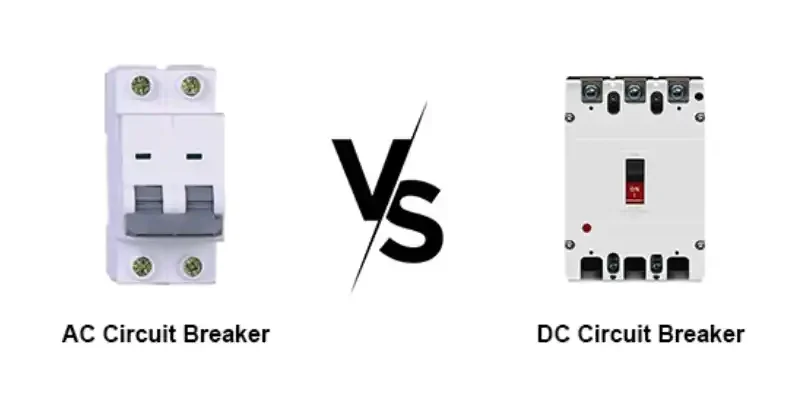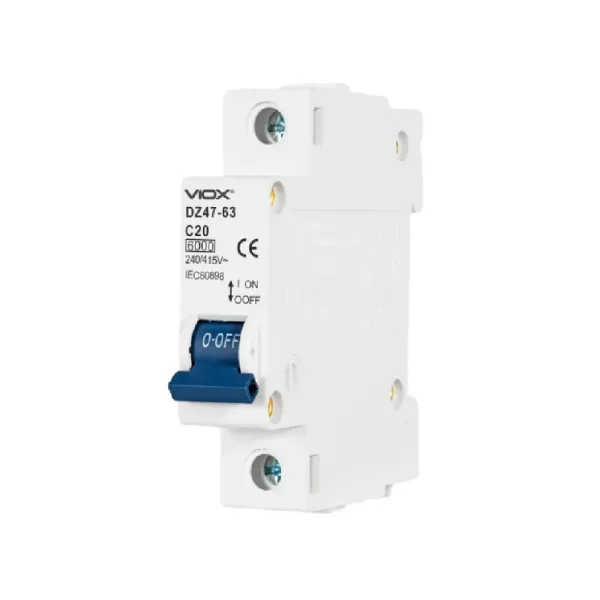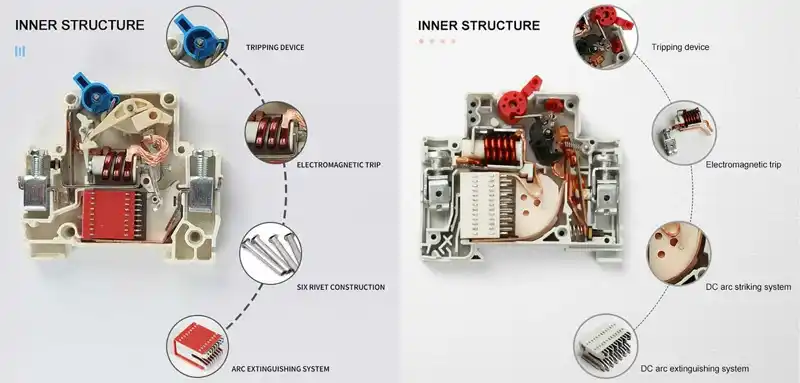
Vad är DC- och AC-brytare?
Definition av DC-brytare

En likströmsbrytare är en anordning som skyddar utrustning från skador orsakade av oavsiktlig kontakt med likström. Det är en viktig säkerhetsmekanism i elektriska system. Likströmsbrytare är specifikt konstruerade för att hantera de unika utmaningarna i likströmssystem där elektricitet flyter kontinuerligt i en riktning.
Viktiga egenskaper hos likströmssystem:
- Strömmen flyter i en enda, konstant riktning
- Spänningen förblir konstant (växlar inte)
- Vanligt i solpaneler, batterier och elfordon
- Kräver specialiserade avbrottstekniker
Definition av AC-brytare
En växelströmsbrytare är en överströmsskyddsanordning som arbetar med växelström. Denna ström ändrar riktning många gånger på en sekund – 50 eller 60 gånger, beroende på elsystemets frekvens.
Viktiga egenskaper hos AC-system:
- Strömmen växlar riktning 50–60 gånger per sekund
- Spänningen passerar noll två gånger per cykel
- Standard i bostads- och kommersiella byggnader
- Lättare att avbryta på grund av naturliga nollgenomgångar
Kritiska skillnader mellan DC- och AC-brytare
Bågsläckning: Den grundläggande skillnaden
Till skillnad från växelström passerar inte likström naturligt genom en nollpunkt, vilket gör det svårare att avbryta och släcka ljusbågen. Därför kräver likströmsbrytare en mer komplex design för att effektivt släcka ljusbågen.
Släckning av AC-båge:
- Eftersom växelströmmen växlar mellan positiv och negativ spänning finns det två punkter i varje cykel där spänningen är noll. När kontakterna separerar och en ljusbåge bildas, försvinner ljusbågen inom 1/120 sekund.
- Naturliga nollkorsningar hjälper till att bryta kretsen
- Enklare interna designkrav
DC-bågsläckning:
- I likström där spänningen är kontinuerlig är ljusbågen konstant och mer motståndskraftig mot avbrott. Av denna anledning måste likströmsbrytare inkludera ytterligare ljusbågssläckningsåtgärder: de har vanligtvis en mekanism för att förlänga och sprida ljusbågen för att förenkla avbrott.
- Kräver magnetiska utblåsningsspolar eller speciell kontaktgeometri
- Mer komplex och dyr konstruktion
Spänning- och strömhanteringskapacitet
Här är en tabell som visar de viktigaste tekniska skillnaderna mellan likströms- och växelströmsbrytare:
| Funktion | DC-kretsbrytare | AC-brytare |
|---|---|---|
| Arc Extinction | Specialiserad för likström: Jämfört med traditionella växelströmsbrytare har de fler fördelar när det gäller att hantera likströmsbågar och kan effektivt släcka bågar. | Naturlig nollkorsningsassistans |
| Spänningsvärden | Likspänningar kan gå upp till 600 volt i bostäder och 1 000 eller 1 500 volt i kommersiella projekt. | Standard 120V, 240V, 480V-klassificeringar |
| Kontakt Design | Det finns två huvudkontakter för likström och tre för växelström | Tre huvudkontakter för AC-system |
| Prispunkt | Högre pris: På grund av den speciella designen och materialkraven för likströmsbrytare är deras priser vanligtvis högre än traditionella växelströmsbrytare. | Lägre kostnad tack vare enklare design |
| Storlekskrav | Stor storlek: Vissa typer av likströmsbrytare kan vara större och uppta mer installationsutrymme på grund av deras krav på ljusbågssläckning och värmeavledning. | Kompakta standardstorlekar |
Säkerhetsstandarder och certifieringar
UL 489-standarder:
Denna standard täcker enheter klassade för 1000 volt AC och 1500 volt DC eller mindre och 6000 ampere eller mindre. Både DC- och AC-brytare måste uppfylla rigorösa säkerhetstester, men UL 489-certifiering är den högsta säkerhetsstandarden för automatsäkringar. Den är specifikt utformad för skydd av gren-/fristående kretsar.
Användningsområden: När man ska använda DC- kontra AC-brytare
Applikationer för DC-brytare
Solenergisystem:
- Likströmsbrytare är särskilt viktiga i scenarier med höga säkerhets- och tillförlitlighetskrav, såsom solcellsproduktion
- Krävs enligt NEC-föreskrifter för solenergi- och lagringsprojekt
- Hantera höga spänningar från solpanelsträngar
Laddning av elfordon:
- Elfordon (EV): Kräver kompakta, högpresterande brytare som kan hantera höga likströmmar
- Avgörande för snabbladdningsstationer
- Batteriskydd i elbilssystem
Batterilagringssystem:
- Likströmsbrytare har en avgörande roll för att skydda batteribanker, solcellspaneler, växelriktare och mer.
- Förhindra termisk rusning i litiumbatterier
- Viktigt för off-grid kraftsystem
Industriella och järnvägstillämpningar:
- Industriella och järnvägsapplikationer: Kräver kraftiga brytare med hög brytkapacitet
- Motorstyrning i DC-drivsystem
- Skydd av tunga maskiner
Applikationer för AC-brytare
Bostads- och kommersiella byggnader:
- AC-brytare är vanliga i nätanslutna elsystem
- Standard i hem och kontor
- Skydda hushållsapparater och belysningskretsar
Nätanslutna system:
- Skydd för huvudelpanelen
- Skydd för matar- och grenkretsar
- Industriell motorstyrning (växelströmsmotorer)
Hur man väljer rätt strömbrytare
Kriterier för val av DC-brytare
1. Val av spänningsklassning:
Säkringen bör vara dimensionerad för den maximala spänningen för solpanelerna eller panelsträngen. Till exempel 12V DC-brytare, 24V DC-brytare och andra.
⚠️ Säkerhetsvarning: Använd alltid en brytare som är specifikt klassad för likspänning och -ström. Välj en brytare med en spänningsklassning som är lika med eller högre än systemets maximala likspänning.
2. Beräkning av strömklassificering:
Säkringen bör vara dimensionerad för den maximala ström som solpanelen eller panelsträngen kan generera under normala driftsförhållanden. Till exempel: 100 A DC-brytare, 100 A DC-brytare, 200 A DC-brytare, DC-brytare 250 A och andra.
3. Krav på brytkapacitet:
Brytförmågan är den maximala ström som en brytare säkert kan bryta utan att skadas. Detta är särskilt viktigt för batterisystem där kortslutningsströmmarna kan vara extremt höga.
Avbrytningskapacitet med spänning
Här är en tabell som visar typiska brytkapaciteter för likströmsbrytare:
| Systemspänning | Typisk avbrottskapacitet | Vanliga tillämpningar |
|---|---|---|
| 12V likström | 5000A vid 12V | Fordon, husbilar, små solceller |
| 24V DC | 3000A vid 24V | Marin, telekommunikation |
| 48V likström | 1500A vid 42V | Datacenter, telekom |
| 125V likström | 10 000–25 000 A | Industriella system |
| 600V likström | 14 000–65 000 A | Stora solpaneler |
Kriterier för val av AC-brytare
1. Standardspänningsklassificeringar:
- 120V för bostadsbelysning och uttag
- 240V för stora apparater och VVS
- 480V för kommersiella och industriella tillämpningar
2. Nuvarande betygsformel:
Beräkna baserat på 125% av förväntad lastström enligt NEC-krav:
Brytarklassificering = Lastström × 1,25
3. Avbrottskapacitet:
- Bostäder: 10 000 AIC typiskt
- Kommersiellt: 22 000–65 000 AIC
- Industri: Upp till 200 000 AIC för applikationer med höga fel
Kodöverensstämmelse och säkerhetskrav
National Electrical Code (NEC) Krav
Krav för likströmskrets:
INUTI byggnader måste DC-kretsar för PV-system som överstiger 30 volt eller 8 ampere placeras I metallkanaler, eller metallklädd kabel av typ MC som uppfyller 250.118(10), eller i metallkapslingar.
Spänningsbegränsningar:
En- och tvåfamiljshus är fortfarande begränsade till 600 V likströmskretsar, och andra byggnader är fortfarande begränsade till 1 000 V likströmskretsar.
Obligatorisk märkning:
Följande kopplingsmetoder och kapslingar som innehåller ledare för likströmskretsar i PV-systemet ska märkas med texten FOTOVOLTAISK KRAFTKÄLLA eller SOLCELLVIKSTRÄCKSKRETS med hjälp av permanent fästa etiketter.
Krav för professionell installation
🔧 Experttips: Höga installationskrav: Eftersom likströmsbrytare hanterar likström är deras installations- och kabeldragningskrav höga, särskilt i högspänningstillämpningar, vilket kräver professionell installations- och underhållspersonal.
UL-listningskrav:
- Alla strömbrytare måste vara UL-listade
- UL 489-enheter utvärderas och "listas" för användning som en fristående produkt
- Matcha brytarens märkdata till specifika applikationer
Felsökning av vanliga problem
Problem med likströmssystemet
Bågsvetsningseffekt:
Om en likströmsbrytare inte kan avbryta ljusbågen ordentligt kan kontakterna svetsa ihop. Detta farliga tillstånd kräver omedelbar professionell uppmärksamhet.
Avvikelser i spänningsklassificering:
Att använda en 80VDC-brytare på ett nominellt 48VDC-system kanske inte är tillräckligt eftersom solpanelens tomgångsspänning (Voc) kan överstiga 88VDC före temperaturkorrigering.
Problem med AC-systemet
Störande utlösning:
Orsakas ofta av överbelastade kretsar eller utrustning med höga startströmmar. Lösning: Uppgradera till en brytare med högre märkstyrka eller minska kretsbelastningen.
Problem med dålig kontakt:
I miljöer med hög fukthalt rekommenderas en speciell fuktbehandling för brytare. Denna behandling hjälper till att motstå mögel och/eller svamp som kan korrodera enheten.
Miljöhänsyn
Temperatureffekter
Högtemperaturapplikationer:
Om vanliga termomagnetiska brytare används i temperaturer över 38 °C måste brytaren nedklassas eller omkalibreras för miljön.
IP-klassificeringskrav
För utomhusinstallationer, välj brytare med lämplig IP-klassning:
- IP65Dammtät och vattentät
- IP67Nedsänkningsbeständig för tuffa miljöer
- NEMA 4XKorrosionsbeständig för marina tillämpningar
Snabbvalsguide
För solenergisystem
- DC-brytare krävs för solpanelsträngar
- Spänning ≥ systemets maximala tomgångsspänning
- Nuvarande märkström = 125% av maximal panelutgång
- Måste uppfylla UL 489I-certifieringskraven för halvledarbrytare om avancerad teknik används
För bostadsapplikationer
- AC-brytare för alla hushållskretsar
- Standard 120V/240V-märkning
- AFCI/GFCI skydd där det krävs enligt kod
- Professionell installation rekommenderas
För laddning av elfordon
- DC-brytare för batteriskydd
- AC-brytare för laddningsstationens försörjning
- Hög avbrottskapacitet krävs
- Temperaturnedgradering kan vara nödvändig
Vanliga Frågor Och Svar
F: Kan jag använda en växelströmsbrytare i ett likströmssystem?
A: Att använda en växelströmsbrytare i ett likströmssystem kan innebära säkerhetsrisker och kanske inte effektivt bryter felströmmar. Använd alltid rätt typ av brytare för det specifika systemet för att säkerställa säkerhet och korrekt drift.
F: Varför är likströmsbrytare dyrare än växelströmsbrytare?
A: På grund av den speciella designen och materialkraven för likströmsbrytare är deras priser vanligtvis högre än för traditionella växelströmsbrytare. De komplexa ljusbågssläckningsmekanismerna och specialmaterialen ökar tillverkningskostnaderna.
F: Vilka spänningsklassningar finns tillgängliga för likströmsbrytare?
A: Likströmsbrytare finns i olika märkningar från 12 V för fordonsapplikationer upp till 1500 volt likström eller mindre för industriella och solcellsapplikationer.
F: Behöver jag särskild utbildning för att installera likströmsbrytare?
A: Ja, särskilt för högspänningstillämpningar. Höga installationskrav: Eftersom likströmsbrytare hanterar likström är deras installations- och kabeldragningskrav höga, särskilt i högspänningstillämpningar, vilket kräver professionell installations- och underhållspersonal.
F: Hur beräknar jag rätt storlek på DC-brytare för mitt solcellssystem?
A: Brytaren bör vara dimensionerad för den maximala ström som solpanelen eller panelsträngen kan generera under normala driftsförhållanden. Använd tillverkarens specifikationer och tillämpa NEC 125% nedklassningsfaktor.
F: Vad är skillnaden mellan UL 489- och UL 1077-klassificeringarna?
A: UL 489-certifiering är den högsta säkerhetsstandarden för automatsäkringar. Den är specifikt utformad för skydd av grenkretsar/fristående kretsar medan UL 1077 täcker kompletterande skydd för användning i utrustning.
F: Kan en strömbrytare fungera för både AC- och DC-applikationer?
A: c3controls serie 1100 UL 489 grenbrytare och UL 1077 kompletterande skydd kan hantera både växelströmskretsar och likströmskretsar. Driftspänningarna skiljer sig dock kraftigt åt. Speciella dubbelmärkta brytare finns men har avsevärt olika spänningsklassningar för växelströms- respektive likströmsdrift.
F: Vad händer om jag använder fel typ av strömbrytare?
A: Att använda fel brytartyp kan leda till att felströmmar inte bryts, potentiella brandrisker, kodöverträdelser och utrustningsskador. Det är absolut avgörande att använda rätt typ av brytare för ett specifikt elsystem för att säkerställa säkerhet och tillförlitligt skydd för kretsen.
Professionella rekommendationer
⚡ Säkerheten först: Försök aldrig att byta plats på AC- och DC-brytare. De grundläggande skillnaderna i ljusbågssläckning och strömegenskaper gör detta extremt farligt.
🔍 Kodöverensstämmelse: Kontrollera alltid lokala elföreskrifter och NEC-krav för din specifika tillämpning. Likströmssystem har särskilda krav för ledarskydd och märkning.
🛠️ Professionell installation: För system över 50 V DC eller kommersiella tillämpningar, anlita en kvalificerad elektriker som är bekant med kraven för likströmssystem.
📋 Dokumentation: För detaljerade register över specifikationer för strömbrytare, installationsdatum och testresultat för säkerhets- och garantiändamål.
Att förstå de viktiga skillnaderna mellan likströms- och växelströmsbrytare säkerställer säkra och föreskrivna elektriska installationer. Oavsett om du designar ett solenergisystem, uppgraderar bostadskretsar eller planerar industriella tillämpningar är det viktigt att välja rätt typ och klassificering av brytare för utrustningsskydd och mänsklig säkerhet.
För komplexa installationer eller om du är osäker på val av brytare, rådfråga alltid kvalificerade elektriker som förstår de specifika kraven för din tillämpning och lokala elföreskrifter.
Relaterat
Varför använder vi AC i hemmet och inte DC
En praktisk guide till DC-brytare för solcells-, batteri- och elbilssystem




